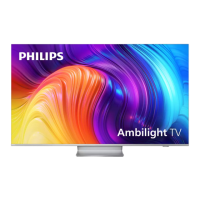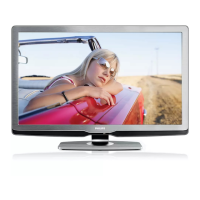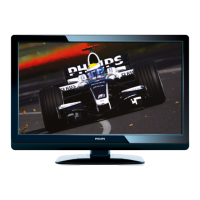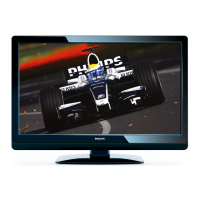
Do you have a question about the Philips PUS8807 and is the answer not in the manual?
| Smart TV | Yes |
|---|---|
| Operating System | Android TV |
| Ambilight | 3-sided |
| HDMI Ports | 4 |
| USB Ports | 2 |
| Panel Type | LED |
| Refresh Rate | 120 Hz |
| Storage | 16 GB |
| Sound Output | 20 W |
| Screen Size | 55 inches |
| Resolution | 3840 x 2160 |
| HDR | HDR10+, Dolby Vision, HLG |
| Processor | Quad Core |
| Wi-Fi | Yes (802.11ac) |
| Bluetooth | Bluetooth 5.0 |
Explains the Android TV Home screen, apps, and live TV channels.
Details installed apps and the Smart TV Collection for premium apps.
Read safety instructions before using the TV.
Instructions for mounting the TV stand and wall mounting.
How to connect the power cable and safety precautions.
How to connect an antenna cable for TV signals.
How to connect a satellite F-type connector.
Explains the functions of each button on the remote control.
Steps to pair the remote control with the TV via Bluetooth.
How to use voice commands for searching content and information.
How to turn the TV on, switch to standby, or power off.
Steps for installing TV channels, including antenna and satellite.
How to tune to channels, switch, and use previous channel.
Guide for installing satellite channels and setting up the TV.
Details on installing up to 4 satellites and Unicable systems.
Step-by-step guide to start the satellite installation process.
Troubleshooting common satellite installation issues.
Guide for installing TV antenna channels.
How to automatically or manually update antenna channels.
Reinstalling all channels while keeping other settings.
Performing a full TV reinstallation and resetting settings.
Steps to copy a channel list to a USB drive.
How to upload a channel list from USB to the TV.
Information on HDMI ports, quality, and copy protection.
Using HDMI ARC/eARC for audio return channel connection.
Operating HDMI CEC compatible devices with the TV remote.
Connecting Home Theatre Systems via HDMI ARC/eARC.
Connecting HTS to TV using HDMI ARC/eARC.
Requirements for using USB Hard Drive for pause/record.
Steps to connect and format a USB Hard Drive.
Process of formatting a USB Hard Drive for TV use.
Connecting a USB keyboard to the TV for text input.
Viewing photos, music, and videos from a USB flash drive.
Connecting a computer to the TV to use it as a PC monitor.
Connecting the TV to a network and the internet for full capabilities.
Connecting the TV to a home network wirelessly or wired.
How to connect the TV wirelessly to a Wi-Fi router.
How to connect the TV to a network router using a cable.
Signing into Google Account to access Android TV features and apps.
Information about Google Play Store and its apps.
Downloading and installing new apps from the Google Play Store.
Setting up, entering, exiting, and deleting a restricted profile.
Viewing TV internal memory usage and free space.
How to start the internet browser and navigate websites.
Using the Quick Menu for quick access to TV functions.
Switching to devices and using One Touch Play for playback.
Connecting the TV to a network.
Information on pairing, selecting, and removing Bluetooth devices.
Adjusting picture settings like style, colour, contrast, and sharpness.
Overview of picture settings and styles.
Selecting and customising preset picture styles.
Adjusting core picture elements like colour saturation and contrast.
Adjusting colour enhancement, gamut, and temperature.
Adjusting hue, saturation, and intensity for colours.
Adjusting contrast modes for energy saving or picture quality.
Adjusting motion styles and perfect natural/clear motion.
Sharpening movement and reducing judder.
Improving motion sharpness and black levels.
Adjusting picture format to fill the screen or maintain aspect ratio.
Adjusting sound settings like style, bass, treble, and equaliser.
Selecting preset sound styles for movies, music, or games.
Configuring speaker virtualizer and Dolby Atmos.
Connecting wireless speakers and setting up home theater audio.
Setting up surround sound with wireless speakers.
Experiencing home theater audio with wireless Play-Fi speakers.
Adapting TV audio signal to user's hearing ability.
Configuring Mimi Sound Personalization and hearing tests.
Controlling HDMI sound system settings via EasyLink 2.0.
Switching between preset sound styles.
Setting TV sound output to TV speakers or connected audio system.
Calibrating TV speakers for optimized sound quality.
Adjusting Ambilight styles, colours, and effects.
Turning the Ambilight feature on or off.
Setting up and formatting a USB Hard Drive for recording.
Adjusting HDMI Ultra HD settings for device compatibility.
Setting signal quality for HDMI ports (Standard, Optimal).
Setting up and cancelling programme recordings.
What is needed to record digital TV broadcasts.
Recording the currently watched programme immediately.
Scheduling recordings for upcoming programmes.
What is needed to pause and resume TV broadcasts.
How to pause and resume a broadcast.
Using the Philips TV Remote App on mobile devices.
Casting apps from mobile devices to the TV via Google Cast.
Integrated centre for information and settings while playing games.
Setting Ambilight to follow video, audio, lounge light, or country flag.
Overview of Alexa voice control operations on the TV.
Setup process for using Alexa voice control on the TV.
Updating TV software from the internet or USB.
Steps to update software via an internet connection.
Steps to update software using a USB flash drive.
Information on TV side and bottom connectivity ports.
Specifications for audio output power and sound technologies.
Running diagnostic tests to check TV condition.
Solutions for common TV issues like power, sound, and picture.
Troubleshooting TV not switching on or remote control issues.
Troubleshooting picture problems like distortion or no picture.
Troubleshooting sound issues like no sound or poor quality.
Troubleshooting HDMI and USB connection problems.
Troubleshooting Wi-Fi and internet connection problems.
Important safety instructions for using the TV.
Key safety information to read before using the TV.
Precautions to prevent electric shock or fire hazards.
Safety measures to prevent injury or damage to the TV.
Precautions to avoid damaging the TV during setup.
Safety advice regarding TV stability and furniture placement.
Preventing overheating by ensuring proper ventilation.
Safety measures to take during lightning storms.
How to clean and care for the TV screen properly.












